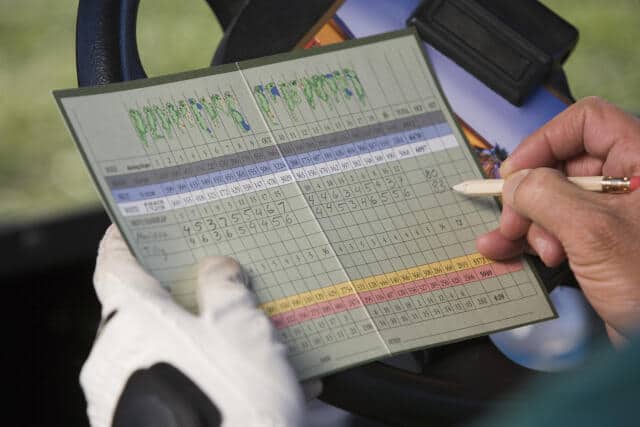If you are serious about your golf game and intend to take part in future official tournaments, then it’s vital that you first understand the basics of playing golf.
Handicap is a critical factor that helps you monitor your level and progress; a number that puts you on a golf skill scale and allows you to compare yourself to and compete against other golfers of different skill levels.
Many variables come into play when discussing handicap, and we will cover the topic in as much detail as possible. All the whys and hows will be answered in this article.
In the end, you will have enough knowledge about handicap to calculate it yourself (either automatically or manually). All you need to do for now is to keep reading!
- 1) What Is a Handicap in Golf?
- 2) Why Do We Need Golf Handicap?
- 3) Handicap Index vs. Course Handicap
- 4) How to Calculate Golf Handicap (as of 2020 Onwards)
- 5) World Handicap System Changes and History
- 6) Golf Handicap Categories
- 7) How Often Should You Calculate Golf Handicap?
- 8) What’s a High Handicap Golfer?
- 9) What Is Considered a Low Golf Handicap?
- 10) What Is a Typical Golf Handicap for a Beginner?
- 11) How to Become a Single Digit Handicapper in Golf?
- 12) What Is the Meaning of a Scratch Golfer?
- 13) Final Thoughts
What Is a Handicap in Golf?

In golf, a handicap is simply the difference between the total golf course par and the average number of strokes a golfer plays in about 10 games. Par is the number of strokes a golfer should take to finish the course (or hole.)
In other words, it refers to a numerical figure that reflects a player’s skill level. It shows your position (as a golfer) on the skill scale compared to other players. The lower the number, the more skilled a player is; the higher the number, the less skilled!
Typically, an 18-hole course Par is 72 strokes, and the number of shots a player needs to make to complete the course represents their handicap.
For instance, if you complete a course with 90 strokes, then your handicap is 18, meaning that you went 18 strokes over par (and as such, you are a ‘bogey golfer’). If you complete the course with 80 strokes, then your handicap is 8.
Knowing your handicap can help you a lot. You can choose to play against other players with the same handicap and play a much better golf round. But even if you play against more skilled players, the handicap system can still be useful.
Let’s say that you have an average handicap of around 15 (The average strokes are around 90 for both men and women), and you are playing against a better player with a handicap of 8. At the end of the round, you score 85 strokes (13 over par), but the other golfer scores 82 (10 over par). Even if the other player needed fewer strokes, you would be considered victor using the handicap system: you get -2, while the other player gets +2 in your handicap levels.
Why Do We Need Golf Handicap?

Golf handicap can be useful for many reasons. First of all, it helps us understand our game better. It also allows us to compare ourselves with others who play at our level.
Also, knowing our handicap allows us to know what we can expect from our games. Knowing this helps us plan ahead and prepare well for future tournaments.
Knowing your handicap helps estimate how much time you need to spend practicing before your next round. This information can help you decide whether you should practice only during weekends or even on weekdays as well.
Also, knowing your handicap can help you set realistic expectations for yourself. If you know your handicap, you can determine whether you are capable of winning a certain tournament.
Your handicap can also be helpful in tracking and monitoring your game improvement and acting accordingly. If you are not satisfied with your progress or feel like you don’t have enough time to practice, you can always ask your coach to help you improve your swings and your game overall. He/she can provide you with tips and advice that can help you improve your game significantly (More on those below).
Still, perhaps the most important benefit of handicap systems is that they try to level playing fields for golfers with different skill levels. So you can compete against better players but still have a chance to win thanks to the handicapping system; weaker players are sometimes able to reduce strokes from their scores on certain holes (Using ESC – Equitable Stroke Control).
Handicap Index vs. Course Handicap
Sometimes, you may hear the two terms ‘handicap’ and ‘handicap index’ being used interchangeably. There are, however, differences between the two.
A handicap is usually a self-proclaimed number. If you ask any golfer about their handicap, they will simply give you a number that they calculated themselves (from a 9 or 18-hole round).
A handicap index, on the other hand, is an official number that is assigned by the golf authority in the country where the golfer lives to represent their potential scoring ability – The USGA handicap system in the United States or the CONGU system in the UK, for example.
Your handicap index (calculated and assigned by a governing golf authority) is an official number that is compared to the course rating and then converted into a course handicap.
Course rating (also called scratch or standard rating) refers to the average score of a scratch golfer (that can play to a handicap of zero at rated courses). It is generally between 67 and 77 strokes for a 72-par course. The USGA course rating system minimally takes into consideration the course length and obstacles.
However, the USGA handicap system uses other factors such as the length of the roughs, wide or narrow fairways, size of the greens and their contours, altitude, weather conditions, course set-up, etc. The USGA system is a bit more complicated and uses more factors to assess the difficulty of the course, and it is used in other parts of the world outside the USA.
In the end, your course handicap needs to be a whole number. You can get your course handicap by multiplying your handicap index by the Average Slope Rating (which measures the difficulty rating of obstacles for players that are not scratch players compared to scratch golfers) of your course and tee and then dividing by 113.
However, the formula has been updated after the new handicap calculation changes were introduced in 2020 and has become as follows (For the details, check the following section):
Handicap Index X (Slope rating / 113) + (Course Rating – Par)
The following video (1 minute 19 seconds) explains how and why course handicap and slope rating are calculated using the world handicap system:
How to Calculate Golf Handicap (as of 2020 Onwards)
You may be asking yourself how you can calculate your handicap, as of the 2020 changes. There are two different ways of doing it: the easy way and the accurate way.

You can calculate your generic handicap by counting the number of strokes you are over par. For example, if you score 90 strokes on a par 70 course, then your handicap is 20. This is a very simple way of calculating your handicap, but it is far less accurate than the official way!
To calculate your official handicap (Using the USGA method), you can use the official scorecard to get your handicap more accurately.
According to the USGA, a player must have at least 12 established golf rounds (either 18-hole scores or combined 9-hole scores). The best and the worst rounds are then discarded. It should be noted that the 12 rounds cannot be played over a very long period but need to be consistent over a specific time to get the most accurate results.
Also, the scorecards must be signed by two people: yourself and your accompanying partner. This measure is intended to prevent fraud and minimize corruption in the scores.
Let’s explore how the final handicap is calculated step by step:
Step1:
Have your scores of the 12 rounds ready. These can be figured out after five rounds, but 12 will give more accurate scores.
Step 2:
Find your adjusted gross score. It is a figure that represents a restriction on the number of strokes that can be entered in any given hole. The adjusted gross score depends on your course handicap. Here is how to get it:
- Handicap of 40 or above: Your maximum score is 10.
- Handicap between 30 and 39: A maximum score of 9.
- 20 to 29: A score of 8.
- 10 to 19: A score of 7.
- 9 or less: A score of Double Bogey.
Step3:
For each score, calculate the handicap differential. You can get it using the following formula:
Handicap differential = (Adjusted Gross Score-rating of the course) X 113 / Courseslope rating
Usually, the slope rating of every course is marked on the scorecard; if it is not, you will be able to get it from the golf club assistants. It shows the level of difficulty of a course for an average golfer
Step 4:
Choose your lowest handicap score differential. In case you have more than 20 scores, then 10 of the latest scores must be used to calculate the lowest differential.
Step 5:
Out of your 10 calculated score differentials, you need to calculate the average of your best (lowest) three handicap differentials.
Step 6:
Multiply the average differential of your best three handicap differentials by 0.96.
Step 7:
Truncate the final figure. For instance, if the average handicap differential is 13.185, after multiplying by 96% (0.96 for simplicity), the final truncated figure should be 12.6.
Step 8:
The final step is to calculate your course handicap. The new 2020 USGA handicap formula is:
Course handicap = Handicap Index X Slope Rating / 113 + (Course Rating-Par)
For example, using a handicap index of 10, in addition to a 70-course rating, a 121 slope rating (lower than the rating of a course with a standard playing difficulty of 113), and a course par score will give a course handicap of 9.
As you can see, manually calculating your course handicap takes some complex calculations. You can use the steps provided here if you prefer to do things the old way, or you can choose our free handicap calculator to do the job for you.
World Handicap System Changes and History

Even though the first forms of handicapping systems started to be used during the 19th century (It was called the ‘hands-on cap’ and involved the referee and two players), it is believed that there were always thoughts of a similar system that would unify all golf players under one system.
It is believed that the idea could be traced back to as early as the 16th century. Golfers would usually negotiate holes, difficulty and number of strokes for each hole before the game begins.
Since the term ‘handicap’ started to be used in 1850, there were many major handicapping systems in use worldwide, with each system having different rules. By the early 21st century, there were six major recognizable handicapping authorities:
- The USGA handicap system
- The EGA (European Golf Association) Handicap System (EGA)
- The CONGU Unified Handicap System (Great Britain & Ireland)
- The Golf Australia Handicap System
- The South African Handicap System (SAGA)
- The Argentinian Handicap System (AAG)
In 2020, a new unified world handicap system was introduced in an attempt to unify all major systems and simplify the conversion and portability of handicaps between different systems.
It is designed to make handicapping more consistent and fair across the board. The goal is to create a universal handicap system that will work for everyone regardless of where they live.
The WHS was created through cooperation between the USGA, the R&A and various existing handicapping authorities. The new system is largely based on the USGA handicap system. Still, it incorporates some features from all other major systems. It aims at making the game of golf more enjoyable.
Golf Handicap Categories
There are five main golf handicap categories (6 for the CONGU system). Each category provides a buffer zone (A score zone that the player can score within without seeing an increase in his/ her handicap) that equals the number of the category itself. For example, a category 4 handicap player can score up to 4 extra strokes above the competition scratch score (CSS) and still keep his/ her handicap unchanged.
| Category | Handicap | Increase (Over CSS + buffer) | Reduction (Below CSS) | Buffer Zone |
|---|---|---|---|---|
| 1 | 5 or below | + 0.1 | – 0.1 | CSS + 1 shot |
| 2 | 6 to 12 | + 0.1 | – 0.2 | CSS + 2 shot |
| 3 | 13 to 20 | + 0.1 | – 0.3 | CSS + 3 shot |
| 4 | 21 to 29 | + 0.1 | – 0.4 | CSS + 4 shot |
| 5 | 29 and above | + 0.1 | – 0.5 | CSS + 5 shot |
Please note that the increase and reduction numbers refer to how much will be added or reduced from a player’s handicap each time he/she has an adjusted score that is either below CSS or above CSS + buffer.
Additionally, the average golf handicap related to different age categories mainly depends on golfers who regularly keep records of their scores and report them online.
However, since the vast majority of players don’t do it, the provided numbers may need to be slightly adjusted to reflect the actual scores (by adding between 5 and 10 strokes). There are five different handicap categories based on age factors:
- Players aged 20 – 30 have an average handicap of 18 since they score around 90 strokes on a par 72 course.
- Players between 30 – 40 of age score around 92 strokes on average, getting a handicap of 20.
- 40 – 50: These players also average 20 handicap with 92 strokes on average.
- 50 – 60: an average score of 91 strokes, and a handicap of 19.
- 60 and above: 92 strokes on average and a handicap of 20.
- For all golfers, regardless of their age, the average score is 91 and the average handicap is 19 on a par 72 course.
How Often Should You Calculate Golf Handicap?
Handicap is used to gauge a golfer’s ability on the golf course, so it’s crucial to check it frequently to make sure it’s accurate.
The CONGU, for example, conducts three types of reviews in Great Britain and Ireland, which include:
- An annual review is conducted between October and March of each year
- CHR (Continuous handicap review) – identifies players who struggle to play to their handicap
- (GPA) General Play Review/Adjustment – When the handicap committee adjusts the handicap of a player during the season
So if you’re trying to get a better handicap, it can be a good idea to recalculate it more frequently than once a year. You can do this in a number of different ways. The easiest is simply to look up your current handicap online and recalculate it using the new scores.
What’s a High Handicap Golfer?
For the USGA handicap system, the maximum golf handicap allowed for men was 36, while it was 40 for women. However, the maximum handicap was increased to 54 for both women and men after the latest regulation adjustments in the world handicap system of 2020.
A high handicap golfer is one whose handicap is higher than what would normally be expected given his/her skill level, as determined by the most recent official results. A high handicapper might have a handicap of 25-28 if he/she is a beginner, while someone with a handicap of 15-18 could be considered a low handicapper.
Any player with a handicap over 20 can be considered a high handicapper. Almost 81% of female golfers and around 25% of males fall into this category. As a result, it can be further divided into smaller sub-categories:
- A lower-high handicap golfer is someone who usually achieves between 19 and 23 handicaps and may sometimes achieve scores in the high 80s.
- Mid-high handicap players score between 100 and 110 on average. Their handicap is around 30 to 40 over par.
- Higher-high handicap players are the ones that score around 113 to 120 strokes per round. The handicap ranges between 41 and 54.
What Is Considered a Low Golf Handicap?
A low golf handicap is defined as being less than ten over par. Players in this category usually score around 81 or fewer strokes (9 or less over par).
Low handicap golfers are also referred to as ‘single-digit handicappers’. These are very skilled players who constantly achieve scores close to par. They all hope that one day, they will be able to call themselves ‘scratch players’ (that achieve a score of zero strokes over par or less). This is not easy to achieve, but not impossible either!
Once again, we can divide this category into sub-categories:
- Lower single-digit handicap golfers have a handicap of 1 – 3. They can achieve golf scores between 73 to 75 strokes on a par 72 course under normal playing conditions.
- Mid-single-digit handicappers consistently shoot rounds of around 76 – 79, which translates into a handicap of 4 – 7.
- A higher single-digit handicap refers to one between 7 and 9. The scores range between 79 and 81 strokes.
What Is a Typical Golf Handicap for a Beginner?
A beginner golfer may start with a very high handicap that could range anywhere between 50+ and 30+. Hitting the 90 strokes marker (and becoming a bogey golfer) is a very difficult challenge to achieve, but it can be done with the right amount of dedication and practice.
A beginner who is determined enough and follows regular practice routines can see his/her handicap drop very fast. Even if they start with a 50 handicap, they can lower it to around 30 in less than six months and even hit the mid-20s handicap after one year.
As a beginner, if you can achieve scores of around 100 strokes during your first year of playing, then you are on the right path. Combine this with the use of the best training aids, and convenient gear such as balls, wedges, irons, woods, and hybrids specific for high handicap golfers, in addition to constant practice; you will see better results if you work hard enough, especially on your putting and chipping.
How to Become a Single Digit Handicapper in Golf?
A single-digit handicapper is a golfer with a handicap between 1 and 9. Some golfers even aspire to become ‘scratch golfers’ one day (hitting the same strokes as the course rating or lower). These objectives are challenging, but nothing is impossible. Here are some tips that can help you become a single-digit handicap golfer:
- Practice regularly: Practice makes perfect. You should practice as often as possible. The more you practice your swing, the better you will get, and the faster you’ll improve your handicap.
- Always start with a good warm-up. It is essential to warm up your body before any practice sessions. This can help you avoid injury and also perform better and swing faster.
- Take advantage of any available technology. There are some good golf launch monitors and swing analyzers (Trackman, Flightscope, Skytrack, etc.) that can help you improve and analyze your swing speed and tempo. Using technology can help you spot your weaknesses and strengths. If you can invest in a quality golf simulator, you will be able to practice more often.
- Pay special attention to your gear. You need to know which clubs are useful in which situations. Learn how to use your clubs properly.
- Focus on your weaknesses: Launch angles, body posture, grip, the position of your hands, shoulders, knees, etc… Doing so will ensure that you are getting better as a golfer and that you are slowly but surely working to achieve your objective. You can always seek professional help if you feel like you need it.
- Your practice sessions and games should have a purpose. Every time you finish a round, try to reflect on the game and see how you can improve. Also, think about what needs to be done the next time you hit the first tee at the course.
- Treat all practice sessions as official tournaments. Your practice sessions are not intended for relaxation but a chance to improve and prepare for the next competition. Try to achieve the best possible scores, even during practice.
- Set goals and challenge yourself: You need to set achievable goals and work hard to achieve them. Every single goal should be seen as a personal challenge!
- Face your fears: If there is a difficult hole that you feel is intimidating, try to hit it more often to get rid of the stress caused by such challenging situations.
- Be patient: It takes a lot of time and practice to see good results in golf. Just be patient and work hard; you will get to your goal if you are dedicated and persistent.
What Is the Meaning of a Scratch Golfer?
According to the United States Golf Association (USGA), a scratch golfer is a player that can achieve a score that is equivalent to or lower than the course rating system. They need to achieve a handicap of zero in all rated courses.
It seems that this endeavor of becoming a scratch golfer is only possible for a few golfers having exceptional skills (and constantly achieving the lowest scores). If compared to the requirements of becoming a professional golfer, you can see that even most pro golfers will never be able to become scratch golfers. To be professional players, male golfers are required to have a handicap of 4.4, and women must have a minimum of 6.6.
Moreover, a scratch handicapper is also required to hit tee shots of 250 yards and be able to reach a 470-yard hole in two shots (for males). A female golfer needs to hit 200-yard tee shots and reach 400-yard holes with two shots.
The result is that scratch handicappers are very rare. For example, according to the USGA, only 0.37% of female golfers and 1.6% of men qualify as scratch players.
Another term that is worth mentioning is ‘bogey golfers‘; in the USGA handicap system, a bogey golfer is one that has a handicap index of 17.5-22.4 for men and 21.5-26.4 for women. A bogey player usually achieves tee shots of 200 yards (370 in two shots) for men and 170-yard tee shots (280-yard hole in two shots) for women.
Final Thoughts
Throughout this article, we explored one of the most crucial factors that can help you improve and become a better golfer: handicap. All players, be they avid golfers or amateur golfers, can benefit from it.
The newest handicap system that came into play in 2020 was intended to make handicap more portable and usable across different regional golf associations worldwide, regardless of the player’s origins. It also challenges your skills and playing abilities as a golfer; you start with an initial handicap that you try your best to improve (by winning more rounds of golf). A 12-month period of regular practice will be enough to see improvement.
Everything you need to know about the fundamentals of handicapping can be found in this article, from handicap calculation to the ways to improve your handicap and become a low handicapper or even a scratch player. Of course, it all depends on your skills and levels of dedication and determination.
If you still have questions or comments, feel free to contact us. We will gladly assist you the best we can.






Good read
Amazing post